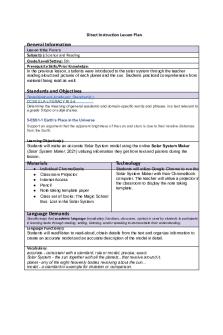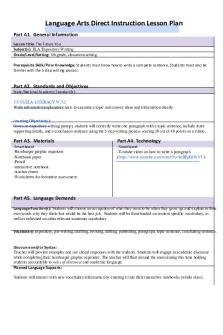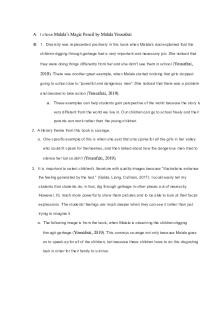BDM2 Task 1 lesson plan PDF

| Title | BDM2 Task 1 lesson plan |
|---|---|
| Author | Patty McDonald |
| Course | Mathematics: Content Knowledge |
| Institution | Western Governors University |
| Pages | 15 |
| File Size | 548.8 KB |
| File Type | |
| Total Downloads | 17 |
| Total Views | 182 |
Summary
Direct Instruction lesson plan...
Description
Direct Instruction Lesson Plan Template
General Information Lesson Title: Identifying and graphing points on the coordinate plane Subject(s): Math Grade/Level/Setting:6th grade Prerequisite Skills/Prior Knowledge: Students will have already worked with the number line horizontally and vertically. Then, students will have mastered graphing order pairs in the first quadrant.
Standards and Objectives State/National Academic Standard(s): 6. NS.C.8 Solve real-world and mathematical problems by graphing points in all four quadrants of the coordinate plane. Include use of coordinates and absolute value to find distances between points with the same first coordinate or the same second coordinate.
Learning Objective(s):
Given an Exit Ticket with 3 problems, students will answer graphing and ordered pair problems, and score at least 2 out of 3 correctly.
Materials
Technology
Teacher will need the Elmo, markers, “Think about it”, “Graphing Ordered Pairs”, “Partner Practice” worksheets, Exit Ticket, Vocabulary and Anchor Chart, pencils, erasers.
Technology will use technology to enhance student learning by using the Elmo to display the worksheets as teacher explains graphing. The Elmo will also be used to enhance student learning when a student writes their answer and thought process on a worksheet displayed on the Elmo.
Language Demands
Language Function(s): Students will analyze and interpret points on a graph using ordered pairs. Students predict locations of points and correct quadrants using thought process. Students will use point of view to explain how they solve problems and explain their process.
Vocabulary: Students will use subject specific vocabulary to evaluate and interpret problems, and to analyze quadrants and placement of points. Students help teacher make charts with content specific vocabulary words, and
Discourse and/or Syntax: Students will use Vocabulary words to describe location of points and labeling the Anchor and Vocabulary charts. Students will use Syntax when using details to explain how they arrive at a decision on graphing a point. Students use Discourse when having thoughtful discussion with their partners.
Planned Language Supports:
Teacher uses introductory lesson to review prior content, partner support for additional support with struggling students, and anchor/vocabulary chart for reference.
Instructional Strategies and Learning Tasks
Anticipatory Set: 20 minutes Activity Description/Teacher Teacher starts by checking for understanding that ordered pairs are listed as (x, y), and that they need to move along the horizontal axis x units from the origin before moving y units vertically on the axis.
Student Actions
The teacher splits the class into peer support groups/pairs and asks them to plot the coordinate (3,2) on the “Think about It worksheet”, and discuss how they knew where to plot the coordinate. This activity serves to activate prior learning. (This activity checks for understanding of a previous skill of graphing in the first quadrant).
Students work in peer interaction/pairs to graph the given ordered pair on a whiteboard placing a marker on the correct coordinate.
After three to four minutes of partner work time, teacher will ask for a volunteer to share their thinking about how to plot the first problem. As the student shares the teacher looks around to see who is erasing, which shows they probably plotted (2,3) instead of (3,2).
Teacher uses whole class instruction to have students work on the next problem on the worksheet where Samuel has plotted the coordinate (5,4). Students will solve this problem on their own, then turn to a partner to discuss their answer. Teacher asks whole class to raise a hand if Samuel is correct. Teacher scans the room to check for student understanding of graphing with ordered pairs. If students need more guidance, teacher will model graphing the first point clearly.
A volunteer shares their thinking on how they plotted the ordered pair. They might share that they moved right 3 and then up two.
Students work independently to think about and answer if Samuel has graphed his ordered pair in the correct coordinate. Students then turn to their partner to discuss the problem further.
Students raise their hands if they believe Samuel’s graphing is correct. If any student is still confused the teacher will cover this concept with them further, practicing more graphing problems.
Presentation Procedures for New Information and/or Modeling: 20 minutes Activity Description/Teacher Teacher explains to students that there are four quadrants, and that ordered pairs can have both positive and negative coordinates. Teacher asks students to think about a way they can use they can determine which quadrant a coordinate point will be placed based on the signs of the x and y coordinate. If, after one minute, students are not sure, teacher will verbally explain the placement of coordinates in the quadrants based on the signs, Teacher will hand out and display the Graphing ordered pairs worksheet on the Elmo. Teacher has students plot the first three coordinates on the worksheet.
Student Actions Students will take one minute to think about how they can determine which quadrant a coordinate will be placed based on the signs.
Students should suggest that you can determine the quadrant of a coordinate point based on the signs of the x and y coordinate.
Teacher asks students to look at the fourth point, (-4 ,0), and put their finger where they think the point should go.
Teacher asks students what they notice about this point. Teacher is looking for students to answer it is on the x-axis, or that it does not go up and down.
Teacher asks students what they can say about the last point, (0, 4). Teacher is looking for students to say that the point does not move left to right, only up and down, or that it is on the y-axis.
For problem 2, teacher asks students to label the quadrants with I, II, III and IV. Teacher goes over the numbers and how they move left in a counterclockwise direction.
Teacher then ask students to name the quadrant that the first three points are in, offering guidance as they answer. This is to clarify the position of each quadrant. Teacher makes a Vocabulary chart with the help of the students. Teacher will read a vocabulary word, with the definition, and ask students to read it back to her as she writes it.
Students will plot the first three points on the Graphing ordered pairs worksheet.
Students place their finger where they believe the coordinate (-4,0) should be placed.
A student volunteer will answer what they notice about this point.
A student volunteer will answer what they notice about the last point.
Students will label the quadrants and teacher goes over each number with them.
Student volunteers will answer which quadrant each of the first three points are in, with guidance from the teacher. Students fill in the correct quadrant number.
Teacher and students make an anchor chart together with steps for graphing points. Students will repeat the definition of the vocabulary words as the teacher writes them on the Vocabulary chart.
Students read the steps on the anchor chart as the teacher writes them.
Guided Practice: 15 minutes Activity Description/Teacher Teacher has students work in pairs to complete the Partner Practice worksheet, problems 1 and 2. Students will answer questions together as the teacher observes their work. Teacher circles the classroom looking for students
Student Actions Students will work with a partner to answer both questions on the Practice and discussion worksheet.
to correctly label the graph and all components, the coordinate pairs on the grid, identifying which quadrant the point is located and that they are describing how to identify and plot a coordinate pair on the grid.
After students have completed the first two problems, the teacher asks a volunteer to explain how they knew where to draw the first coordinate, (2,3). Teacher is looking for answers such as I counted right 2 then up 3.
Teacher asks what would happen if you changed the signs of the ordered pair, (-2, -3). Teacher is looking for students to say that the new point would be in quadrant II, or that they would move left and down.
Together for whole class discussion and to check for understanding, teacher has students complete the last problem on their own, then calls for a volunteer to come up and share their work on the Elmo.
Students will work together to identify coordinates on the grid and the names of the locations for 10 minutes.
A student volunteer will explain how they knew where to graph the first coordinate, and to share their thought process.
Students should be thinking about switching the signs on the first coordinate and where it would be located on the graph. The point will move from quadrant I to quadrant II.
Students work the last problem independently. One student will go up to the Elmo, display their answer and discuss their thought process.
A student volunteer will use the worksheet on the Elmo to show how they decided that Sally’s coordinate of (5,0) was incorrect.
Independent Student Practice: 20 minutes Activity Description/Teacher After class discussion, teacher has students work on the Independent Practice worksheet.
Student Actions Students independently complete the Independent Practice worksheet.
Teacher will circle the class to assist if any students need further instruction. Students will learn about distance in the next unit, but question 13 has them thinking about distance on the coordinate plane.
Culminating or Closing Procedure/Activity: 20 minutes Activity Description/Teacher Teacher labels the coordinate of (-9, -2), and asks
Student Actions Students will say this is quadrant III.
students which coordinate this is located. Teacher has students turn and talk to a partner for one minute and discuss features they observe about points in this quadrant. Teacher is looking for students to say quadrant III has a negative x and a negative y coordinate.
Students turn to a partner to discuss what they observe about the points in this quadrant.
Teacher has student share out their answers. Students share out loud what they observe. Teacher has students work on Exit Ticket for their summative assessment.
Students end class completing their Exit Ticket.
Differentiated Instruction Consider how to accommodate for the needs of each type of student. Be sure that you provide content specific accommodations that help to meet a variety of learning needs.
Gifted and Talented: Gifted students will have two extra problems on their Exit Ticket to challenge them further.
ELL: ELL students will complete partner work with partners that have the same home language as them, with a strong grasp of English to assist them. ELL will also be able to use the Anchor Chart to guide them and the teachers assistance if further help is needed.
Students with Other Special Needs: Students with special needs will have a higher-level partner helping them during partner work and the teacher will assist them in completing the Exit Ticket.
Assessment Formative Students will use the “Think About it”, “Graphing Ordered Pairs, and the “Partner Practice” worksheets to gauge student learning. This will help the teacher gauge student progress so the next lesson can include a review of topics students may be struggling with.
Summative Students will complete the Exit Ticket as the summative assessment. This will gauge student learning and comprehension of the content that has been taught.
Think about it (used in the anticipatory set) Graphing numbers. 1. Solve the problem: Sam wants to plot point A at (3,2). (before)
(after)
Plot Samuel’s coordinate (3,2) on the plane. Explain below how you determined where to plot the coordinates.
2. Samuel plots (5,4) on the graph. Is he correct? Explain your reasoning below.
(Teacher modeling) Graphing ordered pairs
1. Graph each ordered pair on the coordinate plane. a. (2,4) b. (-3,3) c. (-3, -3) d. (-4,0) e. (0,4)
2. Label each quadrant as I, II, III or IV.
3. In which quadrant is a? ___ In which quadrant is b? _____ In which quadrant is c? ____
Coordinate Plane/Graphing Vocabulary chart (Teacher modeling)
Coordinate plane: the result of two connecting lines
Scale- distance between points on the axis
Ordered pair- an ordered pair describes location of a point on a grid. A coordinate pair consists of, in this order, an x-coordinate and a y-coordinate
X-axis- horizontal plane, moves side to side.
Y-axis- moves up and down, vertical.
Origin- the beginning or starting point which is at (0,0).
Quadrants: has the names I, II, III and IV, four parts of the plane.
Integers: All positive and negative whole numbers including 0.
Anchor chart/ (Teacher modeling) Steps for plotting
Step 1: Label all the important features of a coordinate grid, (origin, axes, quadrants, integers)
Step 2: Read the x-axis first, choose if you are moving right or left based on the sign.
Step 3: Read the y-axis and decide if you are moving up or down based on the sign.
Step 4: Plot the coordinates with x first and then y.
Step 5: Label the plotted points with the coordinate pair according to given instructions.
Partner Practice (Guided Practice)
1. This is a map with locations near your home. a. Identify the coordinates of the store ___. b. You leave the store on your bike and ride east 4 blocks and south 2 blocks. What location have you arrived? ___________. 2. You leave the library and ride west 5 blocks and 2 south. a. Which building did you arrive and what are the coordinates? __________. b. Explain the process you used to find the coordinates:
3. Sally says her house is at (5,0). Do you agree? Explain your thinking.
Name______________________________
Independent Practice 1. Write the ordered pair for point A. 2. Write the ordered pair for point B. 3. Write the ordered pair for point F.
4. Write the letter name for the ordered pair at (-4,2). _________
5. Write the letter name for the ordered pair (9,5). ________
6. Write the letter name for the ordered pair (-2, -5). ________
Date____________________
Exit Ticket (Summative assessment) Name______________________________
Date ___________________
Graphing Numbers on the Coordinate Grid: Exit Ticket Use the coordinate plane below to answer questions 1-3.
1. What are the coordinates of point C? ________ 2. Plot Point D at (-10,5). Explain how you plotted the point. ________________________________________
___________________________________________________________________________. 3. In which quadrant is point D located? Explain how you know.
___________________________________________________________________________....
Similar Free PDFs

BDM2 Task 1 lesson plan
- 15 Pages

Task 1 - Lesson Plan
- 6 Pages

Task 1 - Lesson Plan
- 8 Pages

Lesson Plan task 1
- 6 Pages

Lesson Plan / task
- 7 Pages

Lesson Plan - - Task 2
- 7 Pages

Task 1 Math Tools lesson plan
- 13 Pages

C732 Task 1 Lesson Plan - Passed
- 6 Pages

HXM1 Task 1 pdf - lesson plan
- 5 Pages

Geometry Task 2 Lesson Plan
- 7 Pages

C365 Lesson Plan Task 1.docx
- 8 Pages

C970 Lesson - Task 1
- 15 Pages
Popular Institutions
- Tinajero National High School - Annex
- Politeknik Caltex Riau
- Yokohama City University
- SGT University
- University of Al-Qadisiyah
- Divine Word College of Vigan
- Techniek College Rotterdam
- Universidade de Santiago
- Universiti Teknologi MARA Cawangan Johor Kampus Pasir Gudang
- Poltekkes Kemenkes Yogyakarta
- Baguio City National High School
- Colegio san marcos
- preparatoria uno
- Centro de Bachillerato Tecnológico Industrial y de Servicios No. 107
- Dalian Maritime University
- Quang Trung Secondary School
- Colegio Tecnológico en Informática
- Corporación Regional de Educación Superior
- Grupo CEDVA
- Dar Al Uloom University
- Centro de Estudios Preuniversitarios de la Universidad Nacional de Ingeniería
- 上智大学
- Aakash International School, Nuna Majara
- San Felipe Neri Catholic School
- Kang Chiao International School - New Taipei City
- Misamis Occidental National High School
- Institución Educativa Escuela Normal Juan Ladrilleros
- Kolehiyo ng Pantukan
- Batanes State College
- Instituto Continental
- Sekolah Menengah Kejuruan Kesehatan Kaltara (Tarakan)
- Colegio de La Inmaculada Concepcion - Cebu



